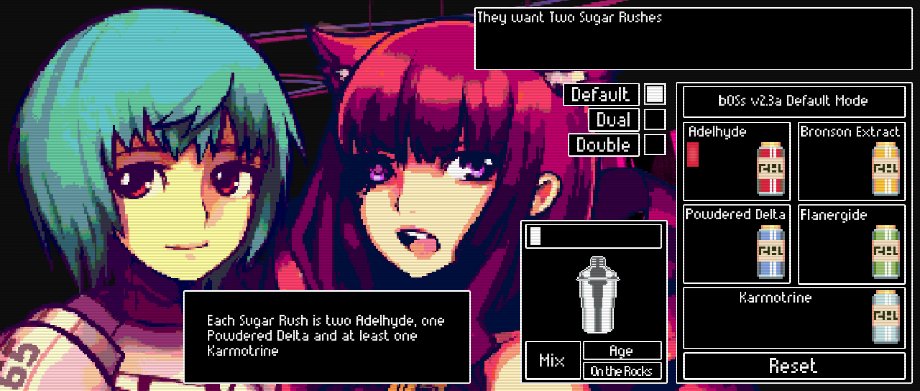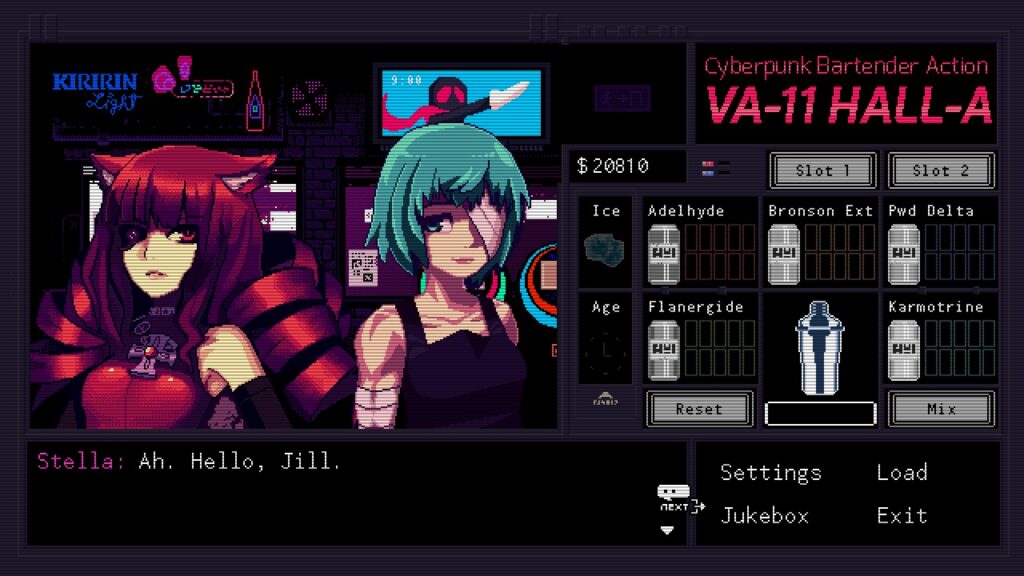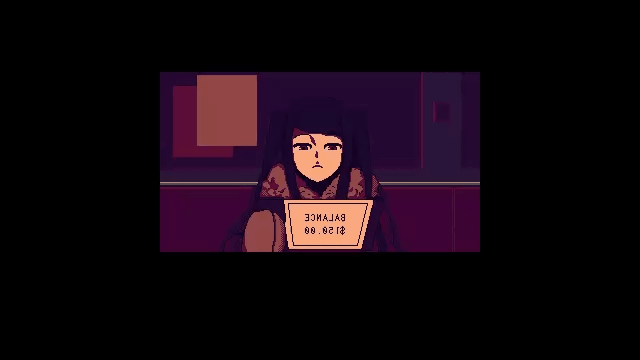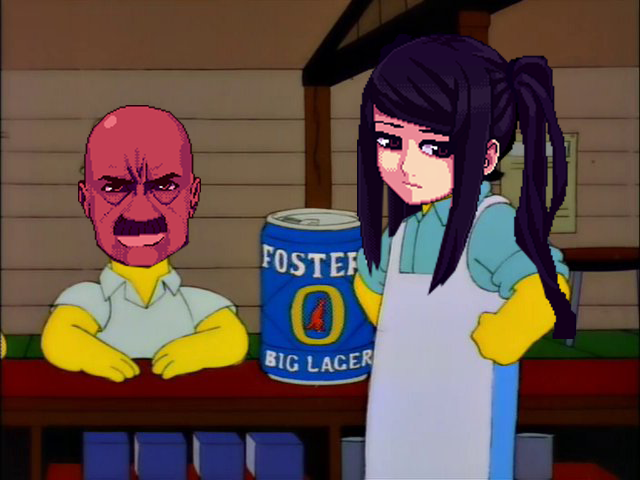In case all these posts haven’t tanked my credibility enough already, I’m gonna tell you another thing that surely will: Did you know I’m not that big a fan of Visual Novels?
Obviously the argument isn’t that simple, which is why I’m elaborating on it here and not in Twitter where the character limit for the post would’ve been hit at around the point where I wrote the word “twitter”, and the first post would’ve been taken as the total sum of the whole argument.
Not to mention that with how many I played during college, you’d have every reason to call me a fucking liar.
That said, the term “Visual Novel” is a contentious one in certain circles. The problem is that it has been used in the west to cover “anything that requires you to read that isn’t a CRPG” or “anything that has text where the character sprites show at the front for conversations”. It’s been used really reductively to lump together games into a more general “Japanese-looking ass game”, but “Visual Novel” IS a legitimate genre.


More specifically Visual Novels are what you could also call “Novel Game”. They’re not “Visual Novels” because of the derisive argument that anything requiring you to read more than 200 words is Cien Años de Soledad, but because by design they’re literally novels with visual elements, to the point where their cadence and style could feasibly be put into plain text no problem.
In other words: Fate/Stay Night is a Visual Novel because you could easily translate it all into a really lengthy Choose Your Own Adventure book. Phoenix Wright is not because there’s too many gameplay prompts where even without branching into account the bulk of the text is fragmented in all the different interactions.
Of course, this is all assuming being pedantic about the semantics of a genre isn’t annoying and something I just criticized a couple of days earlier, but it helps illustrate the idea that what I’m referring to here isn’t just “every text-heavy game ever” but rather “this specific subset of them”.
Now, I could talk at length about how I feel it’s a waste when game’s don’t take proper advantage of their audiovisual elements, but that’s a tale for another day. The “not a fan” element I wanna highlight today focuses on their pacing, more specifically, the lack of… compartmentalization I guess I’d call it.
Let me explain, and let me open by saying that this is a very personal gripe that might not apply to everyone.

Pieces of media have a pacing that requires pace for the consumer to “breathe”. Breaks or pauses in the flow that allow oneself to mentally break what happened from point a to point b.
In books you have chapters or even that thing where they separate sections with double space; in movies you have scene changes or cuts; and in games depending on the genre and format you might have things like enemy waves, levels, checkpoints, or even the usual scene transitions.
With novel games, while you might have scene transitions and the like, it is still a piece of interactive software. In its own language it’s priming you to the concept that “you only stop when you cannot just click to move the dialog forward”.
I mean, obviously you can save anywhere (in most cases) but from the perspective of how games flow that’s not quite as good a breakpoint. Say all you will about “no gameplay” or whatever, but you’re still interacting with it. Any piece of interactive software requires some input from the player to advance the action, giving the player control of the pace. Clicking faster through dialog is, with this mindset, not too different from running past enemy waves in a Souls game to get to the boss.


But even Souls games have points where a player can (and often should) stop, think about where they’re heading, and make proactive choices rather than reactive ones. And even books have an explicit break in the flow of the paragraphs to indicate that there’s a change in scene.
The only explicit breaks in Novel Games that you get happen when you need to make choices or when a chapter ends and maybe you get a save prompt, those are usually the only points where the player has a choice other than “click to advance the text”.
And I don’t know about you, but for me it’s always been a tough ask to spend upwards of an hour reading through a game and THEN being asked to make a choice, expecting me to have processed the last one hour chunk well enough to make it.
Realistically, you don’t even need choices to make this happen, you just need a clearer separation of interactive flow.
How is this related to VA-11 Hall-A? I mean, if I have to spell it out: That’s why you mix drinks so often.

Realistically only about a 4th of the mixes have any tangible effect on the final result (about half instead if you count the process of getting drunk as a relevant flag), and while I wanna talk about our approach to branching later, we explicitly made the mixing to serve the dual purpose of both providing the branching in the narrative but also of creating “mental checkpoints” so the player can digest the beats of the plot better.
Oh yeah, I mentioned “saving anywhere (mostly)”, I should probably make a mental note to explain why you can’t in VA-11 Hall-A within this batch of posts.

If you’re playing along, today’s the 10th day. Jill is processing her grief and Dorothy helps her with it by the end. Did you ever notice that there’s a subset of distracted dialog for this day? You can see them in the code we shared yesterday.
Tomorrow we talk about another fan-favorite scene, so look forward to that.


I’ve seen people describe Hideo Kojima’s games Snatcher and Policenauts as visual novels too even though they are not.
Snatcher has some light gun shooting scenes, a scene that suggests the player to increase the volume of the TV to hear something, and some adventure game-like scenes (not quite visual novel, but neither text adventure not point-and-click either, coming across as a weird hybrid of all three).
Policenauts is also not a visual novel as it has many puzzles not on a visual novel style, many point-and-click scenes, and the aforementioned light gun shooting scenes from Snatcher make a return here too.
i think the pauses to interact more and mix the drinks are the reason why i enjoy playing va11halla but tire of other visual novels
“You can see them in the code we shared yesterday.”
¿En donde exactamente? tanto en el foro como en twitter no vi publicacion del codigo
I sped ahead to day 13, and then took a couple days off, so it’s so nice to go back and read about what I’ve been playing in granular detail. I love the way the drinkmaking gives me a chance to think about the story — I cant put my finger on it, but there is something so special about this game that I can’t find anywhere else. Something about the world building and dialogue that just makes me want to never leave!
This was one of my favourite aspects about the game. I also struggle with visual novels where all you’re asked to do is tapping to read. Sure, the backgrounds, sprites, music and writing is compelling, but as a whole, I feel like the visual novel genre is stuck in this specific framework where they don’t feel the need to branch out and play with more interactive elements other than skipping text (for example the mixing in the game).